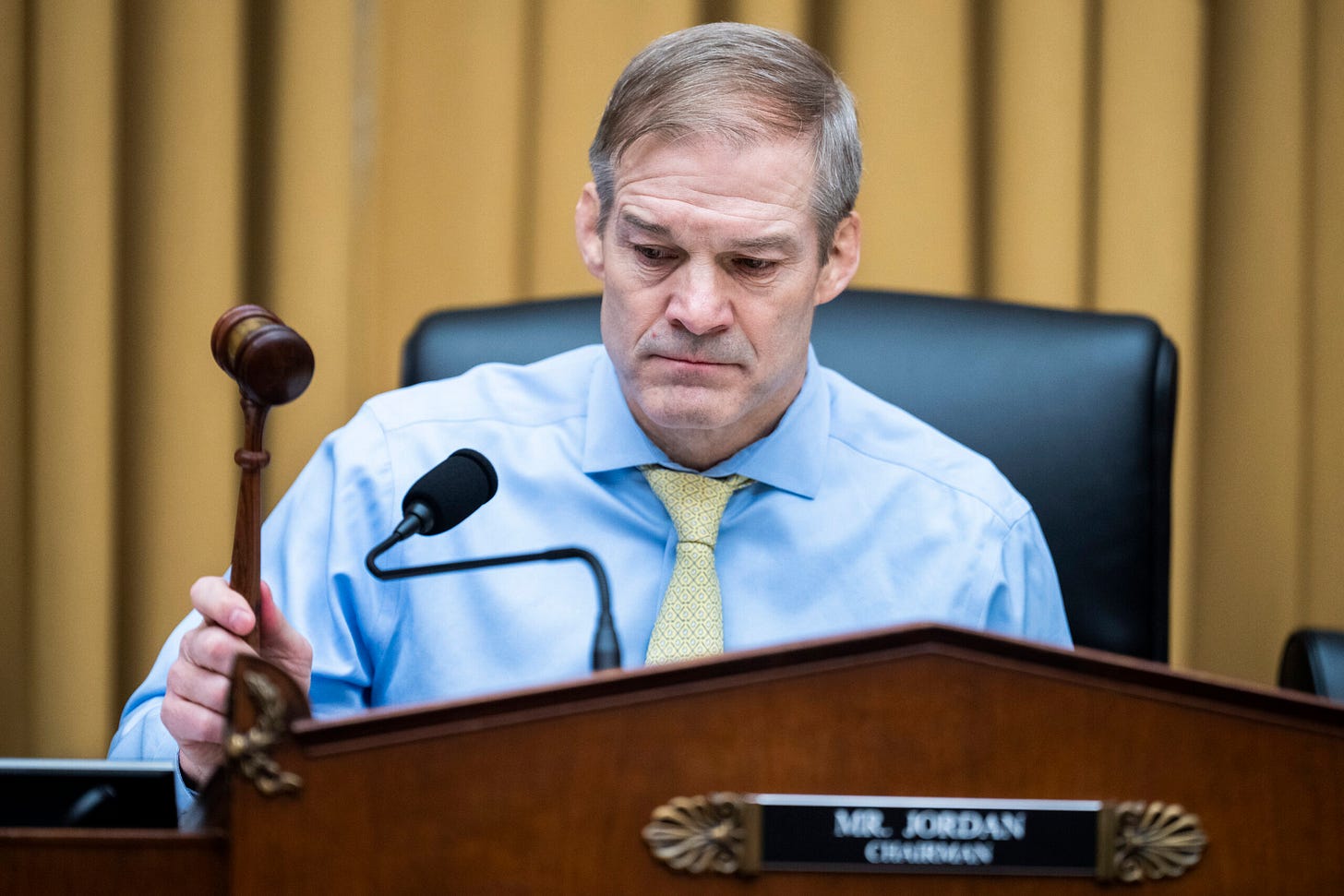Jim Jordan’s Weaponization Subcommittee Keeps Firing Blanks

Jim Jordan’s premise as chairman of the House Subcommittee on the Weaponization of the Federal Government is apparent: If at first you don’t succeed with political stunts dressed up as “investigations,” change the subject and try again.
After an initial February 9 hearing airing old grievances, yesterday Jordan tried what had already backfired for his fellow MAGA committee chair James Comer: a disproven claim that the FBI had censored a Twitter story about Hunter Biden.
But, once again, Jordan’s investigative weapon was loaded with blanks. And he was hunting dead game anyway.
You might remember the backstory: On October 14, 2020, just a couple of weeks before the 2020 election, Twitter prevented its users from linking to a New York Post article about Hunter Biden’s laptop, because the article relied on stolen emails and contained private information. But by October 16, 2020, Twitter had corrected, once again permitting users to post links to the story.
This tired old story was what Jordan chose as the focus of yesterday’s hearing. He brought in reporter Matt Taibbi, who could not substantiate any governmental direction, control, or suggestion to Twitter that they should take down the Hunter Biden story. Moreover, Jordan ignored the fact that a knowledgeable former Twitter executive had testified last month before another House committee that neither the government nor Democrats instigated Twitter’s takedown or even provided information that prompted it.
Whatever credibility Taibbi retained prior to yesterday’s hearing imploded when he stated that this “Twitter File” story was “by far” more “serious” and “grave” than the 2008 fiscal crisis that deflated as much as 40 percent of the world’s wealth:
The lengths to which Jordan would stretch his conspiratorial thinking were on full display. He suggested that merely because the Aspen Institute, a nonprofit think tank, receives government funding and Aspen once ran a training exercise including a hypothetical scenario regarding Hunter Biden and Burisma, he could infer that the government somehow caused suppression of adverse stories about Hunter Biden. Again, no evidence was presented to make such a connection.
Jordan’s vacuous Twitter Files hearing appeared to be an effort to distract from the negative response to his hearing on February 9 resurrecting random MAGA grievances. That first hearing led off with 89-year-old Senator Chuck Grassley as a witness complaining that it was Hillary Clinton and Democrats, and not Donald Trump’s campaign, who had “colluded with the Russians.”
At that hearing, the subcommittee’s top Democrat, Congresswoman Stacey Plaskett, aptly called out Jordan for “weaponizing Congress” and using his subcommittee as “a place to settle scores, showcase conspiracy theories, and advance an extreme agenda that risks undermining Americans’ faith in our democracy.”
Even Fox News host Jesse Waters moaned to Republican committee members, “Tell me this is going somewhere.”
After that first hearing, Jordan shifted attention to his claim that he had “dozens” of “FBI whistleblowers” with knowledge of FBI misconduct directed at Trump. In response, Democratic subcommittee members released a 316-page report documenting that Jordan’s staff could point to only three such witnesses, none of whom actually had direct knowledge of such misconduct.
All three witnesses reportedly endorsed an “alarming series of conspiracy theories”; they were “directly connected to a network of extreme MAGA Republican operatives”; and they were disgruntled former FBI officials receiving financial or other support from Trump allies. In short, they were hardly paragons of credibility.
An unnamed Republican called Jordan’s performance “amateur hour,” suggesting that by advancing conspiracy theories in future televised hearings, Jordan “would make us look like morons.” Back on his heels, Jordan defended his staff as “working their tail off.” But chasing their tail seems more like it.
Jordan’s leadership thus far stands in stark contrast to his initial claim that his weaponization subcommittee would be a modern-day Church committee—the highly regarded 1975-76 Senate Select Committee on Intelligence Activities chaired by Senator Frank Church. In response to that pronouncement, 28 now-prominent Church committee staff sent Jordan an open letter last month laying out the “measuring rod” of the actual Church committee model. (One of us, Baron, was a counsel to the Church committee and involved in drafting that open letter.)
They wrote that the Church committee’s credibility was derived from bipartisanship, collaborative leadership, information-sharing, and consensus-building by majority members with minority members and staff, and restraint in rendering committee findings and recommendations until completion of over a year of exhaustive and objective fact-finding. One example of collaborative investigation aimed at uncovering all relevant evidence: the Church committee’s “majority counsel routinely included minority counsel in witness interviews and closed door deposition questioning of former intelligence agency or White House witnesses.”
Thus far, Jordan’s approach has been the polar opposite. At the February 9 hearing, Democratic member Dan Goldman, a former federal prosecutor, had to cross-examine Jordan publicly to gain access to witness information from Republican staff.
Against this background, if Jordan’s next hearing does not produce weightier and more relevant evidence of government misconduct, Jordan’s weapon may look like a popgun firing a small cork on a thin string.




